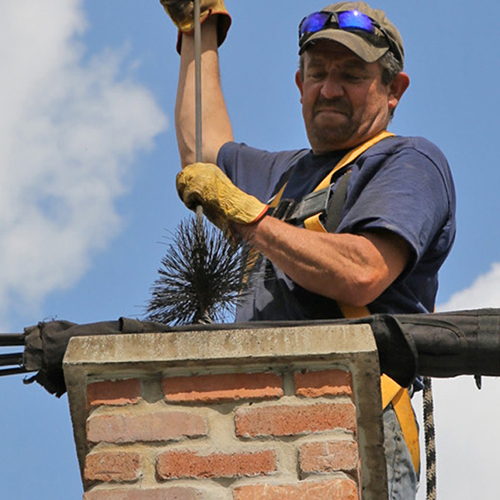Remain Ahead of the Contour: Advanced Chimney Maintenance San Jose Techniques Revealed
Remain Ahead of the Contour: Advanced Chimney Maintenance San Jose Techniques Revealed
Blog Article
Expert Tips for Effective Smokeshaft Maintenance You Need to Know
Chimneys serve as critical parts in lots of homes, supplying heat and convenience. From the significance of regular inspections to secure operational techniques, a detailed method to smokeshaft upkeep is vital.
Significance of Regular Examinations
Routine examinations of smokeshafts are important for ensuring their security and capability. Chimneys play an important duty in venting out harmful gases and keeping proper air flow in a home. In time, creosote build-up, debris, and architectural damages can occur within the smokeshaft, posturing severe dangers such as smokeshaft fires or carbon monoxide leakages.
Throughout a chimney examination, trained experts assess the problem of the smokeshaft, looking for any type of indicators of damage, clogs, or degeneration. They also inspect the honesty of the flue, chimney lining, and chimney cap to make sure everything remains in appropriate functioning order. By identifying and resolving issues beforehand, potential risks or expensive fixings can be avoided.
Routine inspections not only assist in keeping the safety of the chimney but also contribute to its total effectiveness. A well-maintained and clean chimney operates a lot more effectively, making sure appropriate air flow and decreasing the threat of indoor air pollution. As a result, organizing yearly smokeshaft inspections is an aggressive procedure that property owners can require to shield their residential or commercial property and enjoyed ones.
Cleaning Strategies and Regularity
Preserving the safety and security and efficiency of a smokeshaft entails not only normal inspections yet likewise executing suitable cleaning techniques and establishing the optimum frequency for cleansing. Smokeshafts ought to be cleaned by a specialist chimney sweeper a minimum of annually, also if they are not regularly made use of. Nonetheless, if the chimney is used regularly, specifically with wood-burning cooktops or fireplaces, it might need more regular cleansings to stop the accumulation of creosote, a highly combustible compound that can bring about chimney fires.
Homeowners should never overlook chimney cleaning, as it is vital for preserving a risk-free and useful chimney system. Routine cleanings not only minimize the danger of smokeshaft fires however likewise boost the smokeshaft's general efficiency and durability.
Dealing With Chimney Leaks

When attending to smokeshaft leakages, thorough inspection and prompt repairs are critical to stop water damages and preserve the structural stability of the smokeshaft. Leakages in a chimney can lead to severe concerns such as mold and mildew development, damage of the smokeshaft structure, and even potential fire dangers. To successfully resolve chimney leaks, start by inspecting the smokeshaft cap, crown, flashing, and masonry for any signs of damages or wear.
Comprehending Creosote Accumulation
To recognize the possible dangers of creosote build-up in smokeshafts, it is necessary to identify its development process and influence on smokeshaft performance. When timber or fossil gas are shed, Creosote is a brown or black tar-like my latest blog post material that collects inside chimney systems. As smoke rises through the smokeshaft, it condenses and cools down, causing the development of creosote, which complies with the chimney wall surfaces.

Normal chimney inspections and cleansings by a specialist chimney sweeper are critical in protecting against creosote accumulation and guaranteeing the secure procedure of your smokeshaft system.
Safe Operation Practices
Applying proper safety procedures is important for the protected and effective procedure of smokeshaft systems. Always make sure that the chimney is expertly evaluated and cleaned up regularly to get rid of any kind of creosote accumulation, which can lead to smokeshaft fires.
Furthermore, make certain to only shed skilled timber in your fireplace, as eco-friendly or damp timber can produce more creosote and create harmful chimney clogs. Never ever leave a fire ignored and always make certain the fire is entirely extinguished prior to going to bed or leaving the house. By complying with these secure procedure practices, you can enjoy a cozy and warm Clicking Here fire while making certain the security of your home and loved ones.
Final Thought
Finally, preserving your chimney is important for ensuring its safety and effectiveness. Regular inspections, correct cleaning strategies, dealing with leaks, handling creosote accumulation, and following risk-free procedure methods are vital elements of chimney upkeep. By remaining on top of these jobs, you can avoid potential risks and prolong the life-span of your smokeshaft. It is vital to prioritize chimney upkeep to keep your home secure and cozy throughout the chillier months.
Over time, creosote buildup, particles, and structural damages can happen within the smokeshaft, posing significant dangers such as company website chimney fires or carbon monoxide leaks.
If the smokeshaft is utilized frequently, especially with wood-burning cooktops or fireplaces, it might need even more frequent cleansings to stop the build-up of creosote, an extremely combustible material that can lead to chimney fires. (Chimney Maintenance San Jose)
To comprehend the prospective risks of creosote accumulation in chimneys, it is essential to identify its development process and influence on smokeshaft efficiency. As smoke climbs through the chimney, it cools and condenses, leading to the development of creosote, which sticks to the chimney wall surfaces.
Always ensure that the smokeshaft is skillfully examined and cleaned up on a regular basis to remove any type of creosote build-up, which can lead to smokeshaft fires.
Report this page